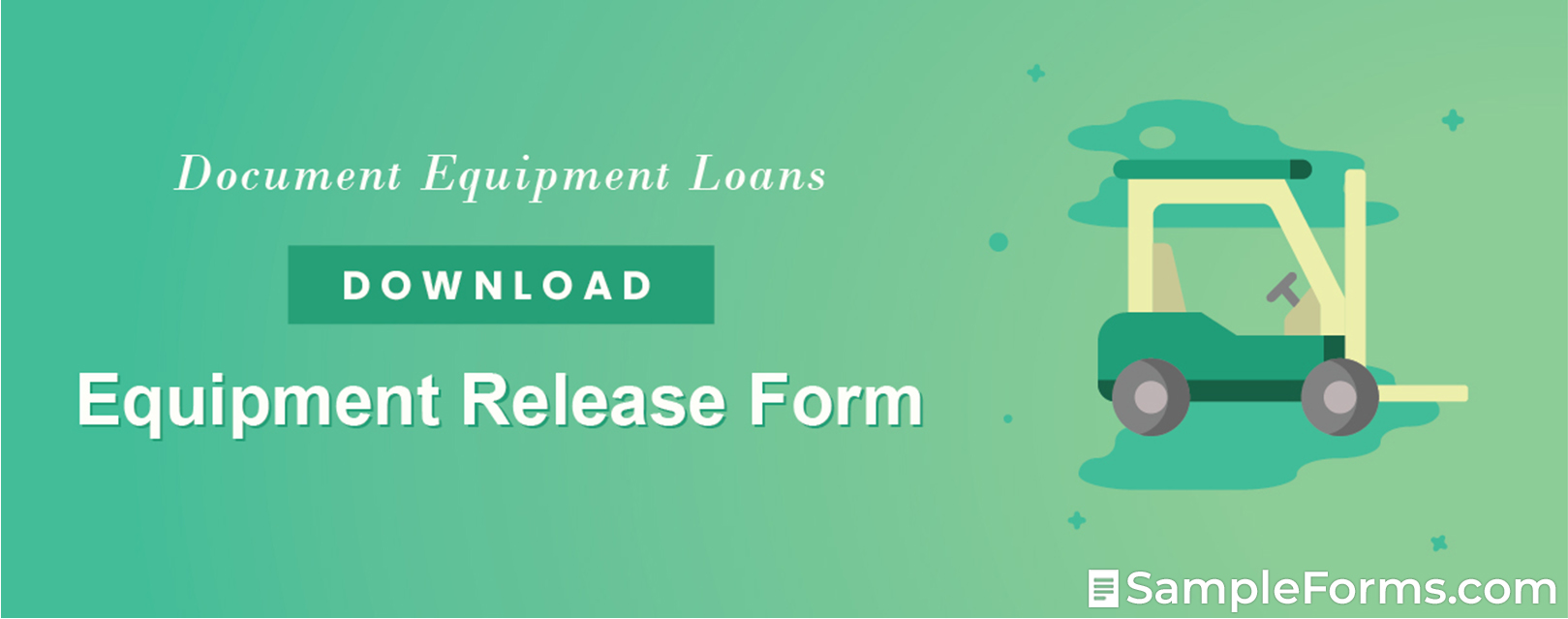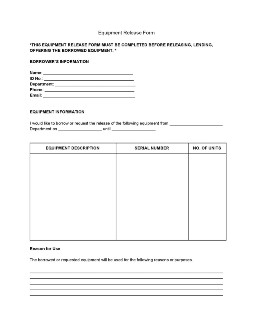- Eviction Notice Forms
- Power of Attorney Forms Forms
- Bill of Sale (Purchase Agreement) Forms
- Lease Agreement Forms
- Rental Application Forms
- Living Will Forms Forms
- Recommendation Letters Forms
- Resignation Letters Forms
- Release of Liability Agreement Forms
- Promissory Note Forms
- LLC Operating Agreement Forms
- Deed of Sale Forms
- Consent Form Forms
- Support Affidavit Forms
- Paternity Affidavit Forms
- Marital Affidavit Forms
- Financial Affidavit Forms
- Residential Affidavit Forms
- Affidavit of Identity Forms
- Affidavit of Title Forms
- Employment Affidavit Forms
- Affidavit of Loss Forms
- Gift Affidavit Forms
- Small Estate Affidavit Forms
- Service Affidavit Forms
- Heirship Affidavit Forms
- Survivorship Affidavit Forms
- Desistance Affidavit Forms
- Discrepancy Affidavit Forms
- Guardianship Affidavit Forms
- Undertaking Affidavit Forms
- General Affidavit Forms
- Affidavit of Death Forms
Equipment Release Form
Using tools and equipment allows us to complete different tasks quickly and easily—without losing a finger or two. And in an organization where everything is done in clockwork precision, lending company equipment is necessary to keep the business running. But more importantly, every equipment borrowed must be well documented and logged in an equipment release form. Learn how to use and make these forms to keep your operations running smoothly and seamlessly. Read More
What Is an Equipment Release Form?
There are different tools and equipment for every type of job. And besides the ones already provided to your employees, they may sometimes need a special piece of equipment for special situations. An equipment release form documents and logs every piece of equipment borrowed from you. It records everything from the borrower’s information, types, and the number of equipment released, as well as their removal and return dates. Additionally, the borrower may also specify the reason and purpose of borrowing such equipment if you wish to require so.
Moreover, an equipment release form also indicates and specifies the party bearing the responsibility for the loss and damages of the borrowed equipment. Other than that, it also indemnifies the company for any damages to property, personal injuries, and other untoward events while using or possessing the borrowed equipment.
Lastly, anyone who wishes to borrow a certain piece of equipment must complete and sign this form before they can get their hands on such equipment. Conversely, the form must also be signed by the custodian in-charge before releasing the equipment to the borrower.
How To Create an Equipment Release Form
Lending and releasing company equipment are very common in the workplace, although not frequently. But, regardless of whether it’s frequent or not, being able to track and account for every piece of equipment means preventing delays from happening anytime in the future—due to broken, lost, and untraceable equipment. Now here are some tips on how to create an equipment release form and implement accountability to things big and small inside your business.
1. Obtain the Borrower’s Information
The last thing you want to do is lend your equipment to a total stranger. So, likewise, the first thing you should do is obtain and know the borrower’s identity before releasing a piece of equipment to them. You can do so, by asking their personal information such as their name, ID number, the department they’re working for, and their contact details. You can also go as far as asking for their address if you feel the need to do so. Or better yet, ask for their IDs as an additional requirement aside from signing an equipment release form.
2. Know the Specifics of Borrowing the Equipment
The next thing you want to know after identifying the borrower is to know the “why’s” and “when” of borrowing the equipment. To do this, you can start by asking when the borrower needs the equipment released to them and when they’ll return the equipment after using it. And, you can then ask for their reasons for borrowing the equipment, or where, or on what job they’re going to use it for. This will help you decide whether or not to release the equipment they need. What’s more, you can also check or verify with their supervisors and prevent losing some of your assets.
3. List all the Equipment Borrowed
An equipment release form documents the release and return of the equipment borrowed for a specific job. So it’s important to make a list of all the equipment requested by the borrower. You can do this by recording the number of equipment that the borrower needs, as well as their type and description. This will let you know the pieces of equipment borrowed, and prevent delays from happening because of missing equipment. To make it more secure, it’s also best to document each of the equipment’s serial numbers.
4. Let the Borrower Agree on Terms and Conditions
Borrowing something may not involve paying a sum for it. However, it doesn’t mean that the borrower can do whatever they want. You must set your terms and conditions for borrowing such equipment, and make sure that the borrower agrees on it. This includes indemnifying yourself and assigning the liability for the equipment to the borrower. This will help you secure yourself and your business from any claims and demands against damages and injuries. It also protects your equipment from misuse, negligence, and from missing as well.
5. Authorize the Equipment Release
Authorizing the equipment release means approving the borrower’s request for a certain piece of equipment. You can do this by signing on the form itself. Authorizing the equipment release happens after verifying the borrower’s identity, identifying the purpose for borrowing the equipment, listing the requested equipment, and setting its release and return dates. This is to ensure that you released the equipment to the right person and prevent you from losing it.
Frequently Asked Questions
Where else can we use an equipment release form?
An equipment release form can be used to release tools, protective equipment, and other equipment in companies, factories, and schools. Even amusement parks and leisure centers can use these forms along with an activity waiver.
Is an equipment release form similar to an equipment lease agreement?
Yes, as both outlines the terms and conditions of borrowing a certain piece of equipment. However, the difference between these documents is that equipment release is for equipment used within the facility. An equipment lease, on the other hand, is for lending equipment to parties outside the facility for a definite period.
What if the borrower doesn’t return the equipment despite signing an equipment release form?
There are many things you can do if the borrower doesn’t return the equipment despite signing a release form. You can either send a demand letter to the borrower—just like you do in personal loans—or sue the borrower for theft.
Lending tools and equipment to those who need it also allows us to achieve a common goal. However, we can never afford to be complacent as these objects can easily be stolen or cause harm to lives and property through misuse. Thus, an equipment release should be required for every equipment that you release to every borrower requesting for it.

